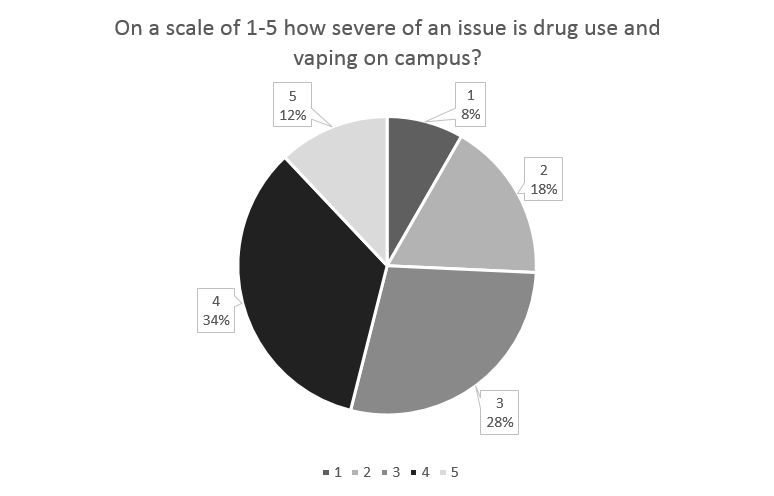By ANIKET MEHROTRA and SABRINA HUANG
Staff Writer and Copy Editor
The growing prevalence of e-cigarettes and vape pens within UHS raises questions on its impact on both the adolescent and the broader community.
Vape pens are used to smoke a variety of drugs, including THC, nicotine and synthetic drugs.
Currently in California, any form of vaporizing device, including e-cigarettes, are considered a tobacco product and are subject to the same taxes as more traditional types of cigarettes.
E-cigarettes are marketed as a replacement to traditional tobacco cigarettes to get smokers to stop smoking, though they still contain nicotine and can give rise to nicotine addiction.
While it is illegal for individuals under 21 to buy vaporizing devices without nicotine, it is legal for them to possess or use.
However, buying and using vaping devices with nicotine are illegal for people younger than 21.
The increased usage of vaporizing devices among youth is often attributed to the variety of vape juice flavors like fruit, candy and pastry flavorings that can be smoked.
In fact, the Centers for Disease Control (CDC) reports that vaporizing devices containing nicotine such as e-cigarettes have multiplied in popularity among high schoolers over the past few years, from 1.5% of high school users in 2011 to 11.3% by 2016.
Though it is not illegal for underage individuals to use vaping products, the Trojan Code of Conduct states that “Students will not use or possess tobacco products (including cigarettes chewing tobacco and electronic cigarettes) at events, such as athletic contests, dances, performing arts, functions, etc.”
Consequences for the possession of such products include parent contact, a mark on the student’s permanent record, enrollment in the Irvine Unified School District Tobacco Cessation Program, referral to the Irvine Police Department (IPD) and a 3-day suspension for subsequent offenses.
All electronic nicotine delivery systems (ENDSs), such as vape pens and e-cigarettes, were initially regulated by the Food and Drug Administration (FDA).
It wasn’t until July 28, 2017 that the FDA lessened its control of the product to “seek public comment on the role that flavors (including menthol) in tobacco products play in attracting youth,” according to the an FDA press release, but also, “in helping some smokers switch to potentially less harmful forms of nicotine delivery.”
This demotion has allowed students to easily possess and use these products.
In an anonymous student survey of 241 students regarding vaping and drug use at UHS, 66.0% of students have seen other students experimenting with drugs on campus.
The UHS administration is aware of the increased usage of vape devices on campus from reports by students, teachers and campus security.
The issue has been discussed at staff meetings and photos of vape devices have been distributed through staff email chains.
Principal Dr. Kevin Astor“Any of it is more than I would like to see on campus, and we’ve definitely seen an increase over the past several weeks and months, mostly due to the fact that the devices are so small,”
said. “The size of the devices appears to have allowed students to do it in classrooms and many of them go unnoticed.”
This increase in the number of students caught for possessing vape devices appears to be sending a message to students who engage in these behaviors.
“A lot of people don’t bring stuff to school anymore, they’re more cautious and more careful,” an anonymous student who confesses to vaping said. “I think it’s good that the administration is enforcing their [zero tolerance] policy and I think at times students don’t understand that what they’re doing is not okay.”
The survey also asked students to rate the severity of the drug use and vaping issue on campus on a scale of 1-5, one being not a problem and five being a severe problem, to which 74.2% of respondents rated the issue a 3 or above.
In addition, when asked to describe the primary motivation behind student drug use and vaping, 56.4% of students listed “Recreation” as one of the primary motivations, 51.9% said “Escape from Stress,” 50.2% said “Peer Pressure,” 47.3% said “Curiosity” and 13.3% said “Focus Better in School.”
For those who have used drugs or vaped, some attribute the rising number of incidents to the competitive nature of UHS.
“I think Uni is a very high-pressure environment, and some students think the only way they can handle the stress is by resorting to these options that are not legal or not okay, and are definitely not healthy for anyone, for themselves or the environment in which they live,” the same anonymous student said.
Other students account for indirect peer pressure as a major cause for students getting involved with vaping and other drugs.
“It’s a gang culture thing. When one of your friends starts to do it, they won’t pressure you to do it, but you’re like ‘Oh, maybe I should try this,’” the student said. “It’s a chain reaction, when one person starts it, it just keeps going until one person finally says, ‘no.’”
The survey also asked students whether or not they think vaping with nicotine is safer than cigarette smoking. 39.8% said they didn’t, 33.6% said they did, 14.1% said they didn’t know and 12.4% said “Maybe.”
The broader medical community is still uncertain whether e-cigarettes are a better alternative to traditional tobacco products.
A study by the University of North Carolina (UNC) found that the same proteins associated with lung cancer in smokers were found in smaller concentrations in the lungs of those who vaped e-cigarettes, caused by the presence of particles from nicotine and flavorings.
Sword and Shield“Both have nicotine which leads to heart disease, heart attacks and high blood pressure,” California Medical Board expert and Assistant Professor at Loma Linda Medical School Dr. James Huang, MD said in an interview with
. “The only advantage of e-cigarettes is that there is less lung damage from the noxious chemicals in the regular cigarettes.”
The UNC study does agree however that for smokers, vaping is a better means of nicotine ingestion, but may also induce a new addiction for the smoker.
Less, however, is known about the effects of nicotine-less vaping.
Vaping at UHS has also drawn attention to the broader problem of drug use on both high school and college campuses around the U.S.
According to the Recovery Village, a foundation aimed at helping people overcome their addictions, 86% of high school students know someone who smokes, drinks or uses drugs.
Meanwhile, drugrehab.com reports that 23% of college students surveyed in 2015 confessed to using illicit drugs like cocaine, amphetamines and heroin in the past month.
Common drugs used by both high schoolers and college students include alcohol, marijuana, adderall, cocaine, heroin, amphetamines, ecstasy, LSD and hallucinogens.
Sword and Shield“Kids initially [often] try these drugs due to curiosity and peer pressure,” Irvine family practitioner Dr. Anita Liu said in an interview with
. “Soon they became addicted to the drugs because these drugs mess up a person’s brain chemical balance which leads them to become irrational and to lose judgement. If they try to stop, they develop withdrawal symptoms which make them feel worse.”
In response to the rising number of students on campus using nicotine-containing e-cigarettes, the administration says its main concern is that students have access to healthier behaviors to deal with the academic and social pressures of high school.
Mr. Kris KoughAccording to Assistant Principal
, turning to drugs and vaping to deal with stress is “not building healthy habits, it’s not building resiliency and it’s not building those life skills of how to deal with that stress.”
The administration hopes that students can make mature decisions for their bodies and livelihoods in deciding whether they should continue these behaviors.
“I would encourage students with any kind of unhealthy behavior to take an honest appraisal of why they’re doing it and see what behaviors they could substitute in lieu of that,” Astor said. “That’s a hard thing to face, and if they don’t know why they’re doing it that’s when they should be reaching out to an adult that they trust.”














